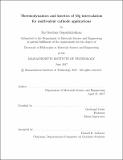| dc.contributor.advisor | Gerbrand Ceder. | en_US |
| dc.contributor.author | Gopalakrishnan, Sai Gautam | en_US |
| dc.contributor.other | Massachusetts Institute of Technology. Department of Materials Science and Engineering. | en_US |
| dc.date.accessioned | 2017-09-15T14:21:02Z | |
| dc.date.available | 2017-09-15T14:21:02Z | |
| dc.date.copyright | 2017 | en_US |
| dc.date.issued | 2017 | en_US |
| dc.identifier.uri | http://hdl.handle.net/1721.1/111245 | |
| dc.description | Thesis: Ph. D., Massachusetts Institute of Technology, Department of Materials Science and Engineering, 2017. | en_US |
| dc.description | This electronic version was submitted by the student author. The certified thesis is available in the Institute Archives and Special Collections. | en_US |
| dc.description | Cataloged from student-submitted PDF version of thesis. | en_US |
| dc.description | Includes bibliographical references (pages 183-204). | en_US |
| dc.description.abstract | Energy storage, especially through electrochemical mechanisms such as batteries, is crucial for sustaining the ever-increasing energy needs of the future in a fossil-free manner. While the current industrial workhorse, lithium ion batteries, has shown tremendous improvements in energy and power-densities, via both materials selection and engineering advancements, the lithium ion technology is approaching the fundamental limits of what more can be achieved. Multi-valent (MV) chemistry, that pairs an energy-dense MV metal anode (such as Mg) with a high voltage cathode has the potential to surpass the energy densities achieved by current Li-ion batteries, along with improved safety and lower costs. However, moving into newer chemistries leads to newer challenges, such as developing cathodes that can reversibly intercalate Mg at high voltages, high rates and high capacities, apart from designing electrolytes that remain stable against both the electrodes. In this thesis, I focus on the challenge of MV cathode design and I explore the thermodynamic and kinetic properties of candidate oxide cathode materials for MV batteries, including polymorphs of V₂O₅, spinel-Mn₂O₄ and layered-Mg₂Mo₃O₈, using first-principles based methods. The undercurrent of the thesis is to obtain design principles that will aid in both optimization of existing cathodes and in the identification of new candidate materials. Utilizing a diverse set of tools, I benchmark the calculated properties, including average voltage curves, lattice parameters, cation-anion decorations in structures and activation barriers for Mg diffusion, to experimental observations, where possible. Finally, this thesis should serve as a guide for other computational-theorists and experimentalists, in the search for an energy-dense MV cathode that will in turn aid in the realization of a high energy density MV battery. | en_US |
| dc.description.statementofresponsibility | by Sai Gautam Gopalakrishnan. | en_US |
| dc.format.extent | 204 pages | en_US |
| dc.language.iso | eng | en_US |
| dc.publisher | Massachusetts Institute of Technology | en_US |
| dc.rights | MIT theses are protected by copyright. They may be viewed, downloaded, or printed from this source but further reproduction or distribution in any format is prohibited without written permission. | en_US |
| dc.rights.uri | http://dspace.mit.edu/handle/1721.1/7582 | en_US |
| dc.subject | Materials Science and Engineering. | en_US |
| dc.title | Thermodynamics and kinetics of Mg intercalation for multivalent cathode applications | en_US |
| dc.type | Thesis | en_US |
| dc.description.degree | Ph. D. | en_US |
| dc.contributor.department | Massachusetts Institute of Technology. Department of Materials Science and Engineering | |
| dc.identifier.oclc | 1003289940 | en_US |
